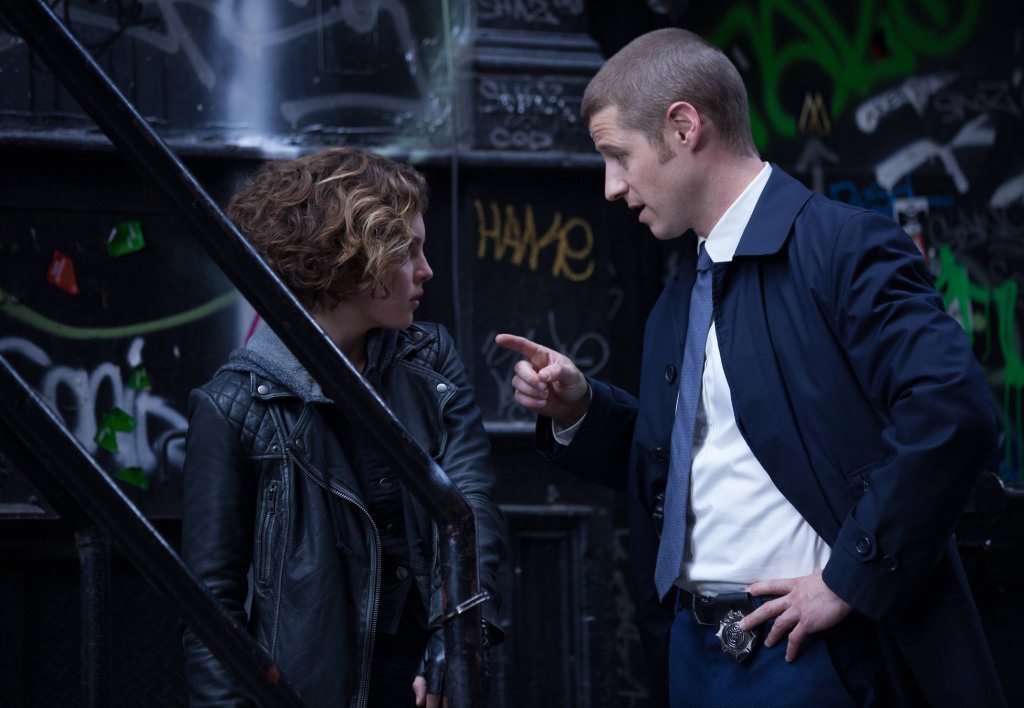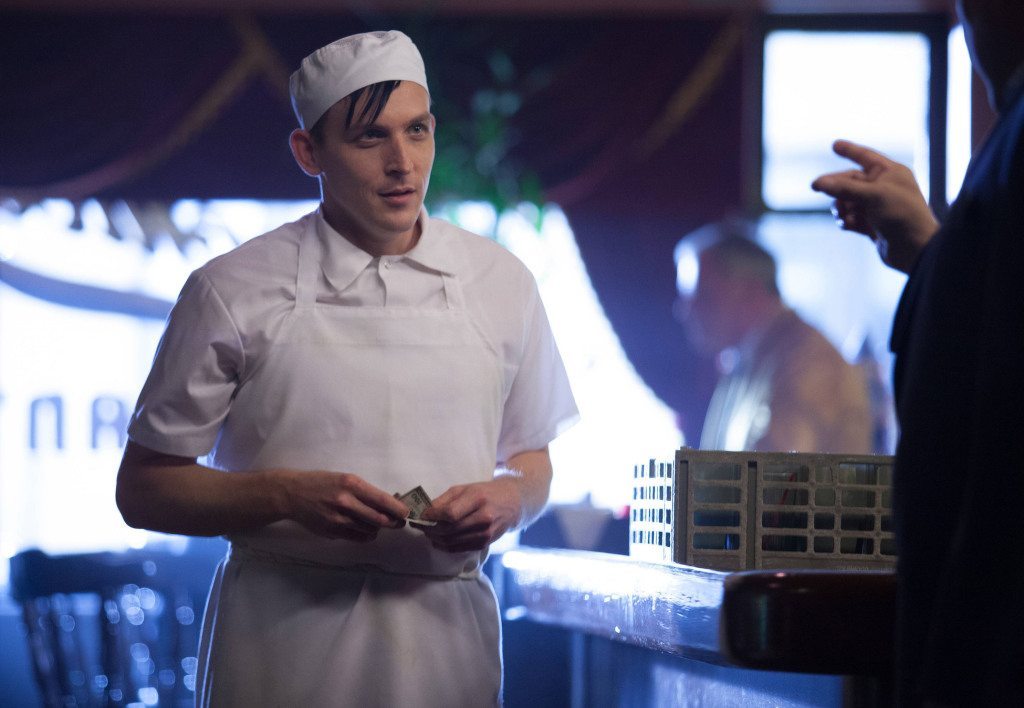There’s a moment in Gotham Central #2 where a retired Commissioner James Gordon gives an impassioned speech to the new class of GCPD officers. He says,”You’re going to make a difference. A lot of times it won’t be huge, it won’t be visible even. But it will matter just the same.” It’s a statement that speaks volumes to how Gordon sees the battle against crime in Gotham versus the way Batman sees that same conflict as well as the incremental fights police officers undertake everyday versus entrenched corruption, violence, and cultural forces which can breed crime. When Fox’s Gotham works best, it works to address those tiny, hopeless fights, the lights that shine in the dark. When it fails, it’s a mess, one more focused on dealing with characters and ideas that by this point, don’t have an established role or place in the war over the soul of the city.
Gotham starts years before Bruce Wayne dawns the cowl in a sort of amorphous time-period. People use cell phones and various technologies but things like the internet don’t seem particularly prominent. Stylistically, Gotham most resembles the city which formed the backbone of Tim Burton’s Batman and Batman Returns films, all Gothic imagery and art deco skyscrapers. Into this city enters James Gordon, a combat veteran of an unnamed war who’s gathered something of a reputation as a hard-nosed cop, fighting criminals and corruption. He comes to the city with his fiancée, the socialite with a dark past, Barbara Kean, and he’s paired in the department with Harvey Bullock, an investigator deeply entrenched in the corruption in the GCPD. He has deep connections in the city’s mafia, particularly Fish Mooney, an underboss for mobster Carmine Falcone.

Season one starts with one in a near limitless long list of times we see the murder of Thomas and Martha Wayne. They’re shot in front of their son, a moon-faced Bruce Wayne, by an unnamed assassin. Selina Kyle, a Dickensian-street-urchin with the characterization of a mix of Michelle Pfeifer’s Catwoman and a particularly sassy anime character witnesses the murder and becomes Bruce and the department’s primary source when it comes to the crime.
Gordon takes the case as his first personal mission to bring down organized crime and tries to connect to a young, scarred Bruce who is put in the care of his butler, Alfred. Bullock tries to put Gordon in connection with the underworld sources that may have information on the case – that brings the pair into Mooney’s circle. Instantly GCPD’s Major Crime Units, led by Renee Montoya and Crispus Allen begin to look into Gordon’s potential connections to organized crime through their undercover source, a young wanna-be wise-guy named Oswald Cobblepot.
From those initial beginnings, Gotham becomes more of a case-of-the-week show. Many classic Batman villains, namely the men and women who will become Poison Ivy, Two-Face, Hugo Strange, Dollmaker, Joker, and Zsasz appear here. Gordon and Bullock investigate crimes throughout the city while a gang war between Falcone and Sal Maroni brews in the background. Most of the mob conflicts come as a result of Cobblepot’s political squabblings.
He’s a social climber, selling out information, dirty deeds and secrets to whoever has the ability to raise his standing. This becomes a major complication of the series and looking at the show from above reveals a tangled, near impenetrable web of motives. At any given point in the series, he’s working for Fish, informing to the Major Crimes Unit, working for Falcone against Mooney, working for Maroni against Falcone, working for Gordon against Falcone and Maroni, and working directly against Mooney. The show plays fast and loose with Penguin’s motives and actions and it’s often the weakest part of any given episode to the point where it’s difficult to tell where his actions and alliances lie.

A second major side-story is Bruce’s relationship with Alfred as well as his search to find why his parents were killed. This is one of the areas of the show that most improved throughout the run. Initially, Alfred is presented as a tough, violent ex-soldier, more used to tending wounds than to children but he softens as Bruce relies on him and their relationship grows to be one of trust and sincerity. Their plots are often connected to Selina Kyle’s, as Bruce grows closer to her and her ability to connect him to Gotham’s underworld.
After 10 episodes, the show finally begins to pick up some steam. Cautious about how much Bruce is learning about his parents murder, assassins are dispatched to take him out. Knowing danger is coming, Gordon sends Barbara away from the city and works with Alfred to protect Selina and Bruce. For his actions and his consistent antagonism to corrupt GCPD commissioner Loeb, Gordon is assigned as a security guard at Arkham Asylum.
While there, he connects with Dr. Leslie Tompkins and eventually is able to be reinstated in the GCPD. The show shifts there and it’s notable because the show was initially only ordered for 13 episodes, which would have ended Season 1 with Gordon’s star rising, putting himself up to be elected as president of the police union. Instead, the show received a three episode extension followed by a full season order. Those final nine episodes, while they do add several additional plot elements which tighten the storyline, are mostly terrible.

These final episodes primarily revolve around Mooney being abducted by pirates who are working in an organ harvesting ring with villain The Dollmaker, a serial killer calling himself The Ogre who kidnaps a now single and heroin addled Barbara Kean, and Bruce finding out that the Wayne Enterprises board was involved in his parents’ death and hired an assassin to find out how much he knows. Bruce’s plot is most interesting of the group as he and Selina investigate an old war friend of Alfred’s who shoots the butler and, ultimately, Bruce presents his findings to the board, who tell him in no uncertain terms he cannot take over.
The final episode ultimately snuffs out the mob war the series has been building to. Mooney and her army of surgical misfits team up with Maroni to bring down Falcone, who Gordon has entered a tentative alliance with in order to bring peace back to Gotham. The relationship between Mooney and Maroni goes south when Maroni acts sexist, Fish shoots Maroni, and the battle erupts. Ultimately, Cobblepot throws her off the roof and claims his role in Gotham’s underworld. Meanwhile, Kean loses her grip on sanity and attacks Gordon’s new girlfriend, Leslie, and criminal pathologist Edward Nygma loses his grip on sanity as the woman he is obsessed with realizes that Nygma is a killer. The season ends with Bruce finding a tunnel in his father’s study, one which opens into a deep, dark subterranean cave.
[youtube http://www.youtube.com/watch?v=AzLGjtpb-lw&w=560&h=315]
I’ll be honest. Gotham is rarely a good show. It’s often a bad or unwatchable one but it’s those small victories, those little steps that make it look like it could become a good one that are worth watching. The fights against corruption in GCPD are what this show could do best and it’s what I want to see the most. Loeb is a character who looms over the early days of Batman comics, serving as Gordon’s first real foil in the classic Batman Year One. Gordon’s encounters with Loeb here have the seeds of what a more police-focused version of this show could be and it showcases what makes James Gordon such an important character in the Batman mythos.
What’s important about Gordon isn’t him making deals with the mob or trying to become a surrogate father for Bruce, it’s about him becoming the shining light of Gotham City’s fight against crime. Gotham is best when it shows his path to heroism and so rarely does the show let that character become the star. Unfortunately, Season 2’s advertising focus seems to be on “Rise of the Villains,” a direction that doesn’t look particularly promising. I’ll be here every week to let you know how it goes.